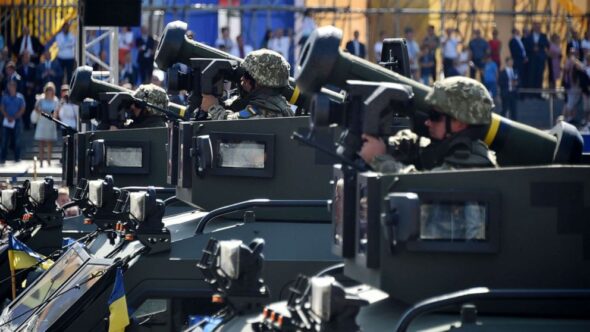Mariusz Marszałkowski, editor at BiznesAlert.pl, summarizes who and with what is armoring Ukraine in the face of a new Russian attack. Just as the Russian military presence on the border with Ukraine continues to grow, so do the deliveries of various types of military equipment from Western countries, which want to help Kyiv in a potential conflict, he writes.
The threat of a Russian invasion
The possible Russian invasion of Ukraine is still up in the air. On the one hand, the Russian Ministry of Defense has announced the completion of another stage of military exercises in Belarus and the return of some military units from the Western and Southern Military Districts to their home garrisons, but on the other, it did not even hint at the return of military units assigned to the Eastern and Central Military District. Various weapons systems are still being deployed around Ukraine, and helicopters and combat aircraft are arriving at airfields and airports.
Just as the Russian military presence on the border with Ukraine continues to grow, so do the deliveries of various types of military equipment from Western countries, which want to help Kyiv in a potential conflict. Ukraine is not a NATO state, so the alliance is not obliged to participate militarily in a possible war, but the supply of equipment necessary for defense can significantly increase the combat capability of the Ukrainian army as well as its morale.
Military support to the Ukrainian armed forces is, generally speaking, nothing new. Some Western countries have supported Ukraine militarily since the beginning of the annexation of Crimea and the conflict in the Donbas. However, the scale and scope of the current support is unprecedented. From 17 January to 15 February 44 flights of transport aircraft took place, which delivered to Ukraine military equipment, including weapons and ammunition. Most of these flights were done by British transport aircraft owned by the RAF: Boeing C-17 Globemaster and Airbus a-400m. These aircraft made at least 19 flights. The second largest air bridge was organized by the Americans, who use National Airlines’s commercial aircraft Boeing 747 and Kalitta Air, which until February 15 made 17 flights delivering more than 1.7 thousand tons of weapons and ammunition of various types and calibers. Several flights with military equipment were also carried out by the Canadian Air Force and the NATO Heavy Transport Wing. In the last month Ukraine was offered military support by, among others, the USA, the UK, Poland, Lithuania, Latvia, Estonia, the Czech Republic and Canada.
What is the West providing to Ukraine?
Since 2014, the scale of military aid Western countries gave Ukraine has exceeded USD 3.5 billion, of which the United States alone contributed at least USD 2.4 billion. The first shipments of foreign aid to the Ukrainian army arrived by the Dnieper in July 2014. Those included, among others, American and French bulletproof vests. Another delivery of US support in the form of counter-mortar radars was carried out in November 2014. In 2015, the US, as well as the UK and Canada and others, continued to supply equipment for Ukrainians. The shipments included, for example, bulletproof vests, night vision goggles, thermal imaging cameras, HMMWV armored cars, light firearms, field hospitals and fast patrol boats. The UK supplied obsolete Saxon armoured vehicles, which, however, did not meet the expectations of even the under-invested Ukrainian army, and were quickly withdrawn from the front line. The supply also included radios and personal protective equipment, as well as anti-tank machine guns. During the hostilities in the Donbas there was a fierce debate about the supply of weapons to Ukraine. The West did not want to support the Ukrainians with the so-called lethal weapons, hence even the supply of American Sniper Rifles M82 Barrett was carried out without much publicity.
In the following years of the frozen conflict in the Donbas, when the Ukrainian armed forces began a slow but consistent process of modernization, the Americans again offered the biggest military assistance. The deliveries of personal protective equipment continued, including bulletproof vests, night vision devices, radios and other means of communication, thermal imaging cameras, telescopic sights and binoculars. In addition, in 2016, another AN/TPQ-36 and AN/TPQ-49 artillery detection radars reached Ukraine. This equipment was extremely valuable for the Ukrainian army, because it allowed to quickly locate the artillery of Russian-backed separatists, which was shelling Ukrainian trenches. Thanks to this, the Ukrainians could accurately respond with counter-battery fire, eliminating the threat. The aid package also included small, hand-launched, surveillance and reconnaissance drones. The constantly supplied equipment was not „lethal”. No equipment was provided that could, in theory, give Russia a pretext for an attack, both a propaganda one against the West and an actual one against Ukraine.
The situation changed in 2018. Sfter many months of diplomatic efforts led by Kyiv the administration of President Donald Trump has agreed to provide as part of military assistance the anti-tank system FGM-148 Javelin. The deliveries, according to Ukrainian sources, were, however, subject to certain restrictions on the use of these weapons in the Donbas. Nevertheless, the very fact of the supply of weapons, the nature of which is extremely offensive was a novelty in the conduct of the broadly-understood West. After the incident in the Sea of Azov in November 2018, when the Russian military forcibly seized Ukrainian ships that were going to cross the Kerch Strait to Ukrainian ports in the sea of Azov, the United States decided to support Ukraine in the ad hoc modernization of the Ukrainian navy. The US delivered two Island patrol boats in 2019, among others.
However, military assistance began to change. While in 2014, 2015 and 2016 the Ukrainian army absorbed all the transferred equipment, later on, after the situation on the front stabilized and the political situation inside Ukraine became more predictable, the domestic arms industry took over the main burden of equipping and arming the Ukrainian army.
However, the Ukrainian army still struggled and continues to struggle with problems, including with advanced anti-aircraft weapons, insufficient ammunition for artillery systems, a navy that is obsolete and unable to conduct combat operations and an air force in poor condition. Kyiv’s requests to the West increasingly concerned precisely this kind of possible support, especially in the field of air defense, which, although numerous, is outdated and not adapted to the conditions of the modern battlefield.
Stepping it up after New Year’s
In the face of increasing tensions around the Ukrainian border in mid-January, after the visit of the Secretary of State Anthony Blinken to Kyiv, the United States decided to increase its commitment to military assistance to Ukraine. The military equipment worth USD 200 million that has been delivered since mid-January is lethal. The supply includes American 7.62 mm machine guns, 12.7 mm machine guns, MK-19 40 mm automatic grenade launchers, anti-tank guns, m-141 SMAW-D grenade launchers, other batches of the anti-tank system Javelin. Another large reinforcement of the Ukrainian army was funded by the British, who in 10 air transports delivered to Ukraine more than 2 thousand modern NLAW anti-tank grenade launchers. In addition, the British also provided, among others, bullet-proof vests and communications equipment for the newly established Ukrainian territorial defense forces.
Among the most active states in terms of military support to Ukraine are the Baltic republics. Estonia announced the transfer of parts of its Javelin and D-30 howitzer systems (for which re-export was not approved by Germany), Lithuania and Latvia offered the portable anti-aircraft Stinger missile systems. In this case, the US State Department had to agree on the transfer, which happened in late January. On February 13, the first transport of Lithuanian Stingers arrived in Ukraine. In addition, the Baltic republics gave a field hospital, HMMWV vehicles and small arms ammunition. The Czech Republic also offered help, and has pledged to provide Ukraine with more than 4 thousand 152 mm artillery rounds.
Poland was also not indifferent in the face of the risk of a Russian invasion on Ukraine. Warsaw decided to give its neighbor the man-portable air-defense system Piorun, which is also used by the Polish army. In addition, Ukraine was to receive tens of thousands of rounds of ammunition of various calibers (both for shooting and artillery). Apart from that, the Ukrainians received light infantry mortars and grenade launchers caliber 40 mm. It is possible that the scope of Polish assistance also included unmanned aircraft sets.
The last country that has declared military aid to Ukraine is Canada, whose Prime Minister on February 14 announced the transfer of lethal equipment worth more than USD 6 million.
Not everyone wants to arm Ukraine
Despite the numerous examples of countries that have declared or are already supporting Ukraine militarily, there are also those that have openly opposed the supply of arms. Austria and Germany are absolutely opposed to military assistance to Ukraine. According to Berlin, the conflict in the east of Ukraine can be resolved only with the use of diplomatic means, and the rearmament of Ukraine increases the risk of the desire to forcibly recapture the Donbas from the hands of separatists supported and controlled by the Kremlin. Despite the skepticism of Germany, the Ukrainian army has acquired a number of important weapons systems, which, in the worst case scenario, can significantly contribute to increasing the cost of a potential invasion. And the supply of additional weapons systems is still taking place.









